Physical Address
304 North Cardinal St.
Dorchester Center, MA 02124
Small bowel neoplasms remain a diagnostic challenge for radiologists and clinicians. The small bowel represents 75% of the total length of the gastrointestinal tract and more than 90% of the mucosal surface, but less than 2% of all gastrointestinal malignancies originate in the small bowel. Malignant tumors of the small bowel may arise from the mucosal epithelium, lymphoid tissue, blood vessels, nerves, and muscle. Secondary involvement of the small bowel is more common than primary malignancies. Considerable delay in the diagnosis of small bowel malignancies leads to low survival rates. Increased awareness of the small intestine as a potential source of nonspecific abdominal complaints or chronic anemia and the selection of the most accurate diagnostic tests would lead to improvement of a patient's prognosis.
In this chapter both secondary and primary malignancies of the small bowel are reviewed, with an emphasis on their imaging findings ( Table 28-1 ).
| Lesion | Age | Sex | Distinguishing Clinical History | Distinguishing Clinical Presentation | Imaging Modality of Choice | Distinguishing Imaging Findings | Enhancement Pattern | Additional Findings |
|---|---|---|---|---|---|---|---|---|
| Adenocarcinoma | 6th-7th decades | M = F | No specific symptoms, high level of suspicion is recommended in patients with long-standing disease, vague gastrointestinal symptoms, and weight loss | Abdominal pain (60%) Obstruction (40%) Gastrointestinal hemorrhage (24%) |
Enteroclysis, CT enterography | Partial or complete small bowel obstruction or intussusception on plain film Barium studies: Apple core lesion, asymmetric wall thickening or infiltrative pattern More in proximal small bowel |
Heterogeneous enhancement (hemorrhage, necrosis, or ulceration in 40% of cases) | Local extension, regional abdominal lymphadenopathy, distant metastases |
| Carcinoid | 6th-7th decades | M = F | Asymptomatic or present with carcinoid syndrome (cutaneous flushing, sweating, bronchospasm, abdominal pain, and diarrhea) | Classic carcinoid syndrome | Abdominal CT, CT enterography, nuclear scan | Intussusception on plain film Mesenteric mass on CT scan |
Spiculated margins, low attenuation Mass with fat stranding and minimal enhancement Hypervascular liver metastases |
“Spokewheel” or “sunburst” appearance on CT Encasement of mesenteric vessels leading to ischemia of affected bowel loops Octreoscan study is more sensitive in localizing carcinoids and metastatic disease compared with CT, MRI, or endoscopy. |
| Lymphoma | Bimodal, <10, >50 | M > F | Chronic anemia, weight loss | Abdominal pain, diarrhea, steatorrhea | Abdominal CT or CT enterography | Four patterns of involvement: (1) multiple nodules at multiple sites; (2) single large mass, triggering point for intussusception; (3) infiltrative pattern, presents as asymmetric wall thickening or aneurysmal dilatation of bowel loop; (4) exophytic mass | Low-attenuation soft tissue mass with minimal enhancement | Enlarged lymph nodes in the chest, abdomen, or pelvis Aneurysmal dilatation of the involved bowel loop without obstruction |
| GIST | 5th-6th decades | M > F | Incidental finding on imaging | Bleeding and abdominal pain; directly correlates with size of tumor | CT enterography or small bowel series | Intramural exophytic mass with or without internal calcifications and necrosis Submucosal lesion with smooth surface and acute angle |
Circumscribed exophytic low-attenuation mass with heterogeneous enhancement depending on hemorrhage, necrosis | Liver metastases can be hypervascular. |
| Metastatic disease | After the 5th decade | M = F | History of a primary neoplasm, especially melanoma or gastrointestinal, pancreatic, or ovarian in origin | Gastrointestinal bleeding, increased abdominal pain, bowel obstruction in patients with known neoplasms | Abdominal CT | Diffuse or nodular peritoneal and intestinal wall thickening “Bull's eye” appearance on barium studies Intussusception |
Variable | Primary tumor and other metastatic disease |
Metastatic disease to the bowel is more common than primary malignancies. Mechanisms of metastatic seeding to the small bowel include intraperitoneal seeding, direct extension along the fascia or mesenteric attachments, hematogenous spread, and lymphatic extension. The mechanism of spread determines the radiologic appearance. Intraperitoneal spread is the most common mechanism and usually occurs as a result of spread via ascitic fluid. The primary neoplasms are usually gastrointestinal in men and ovarian in women. Direct invasion of the small intestine is seen from primary colon, pancreas, biliary, ovarian, renal, and adrenal malignancies. Hematogenous spread of primary neoplasms to the small bowel is rare. Melanoma, lung, breast, kidney, and gynecologic cancers are the most common tumors with embolic spread to the small bowel.
Lymphatic dissemination to the small bowel plays a small role. A typical example is spread of cecal carcinoma to the terminal ileum by retrograde lymphatic flow after occlusion of the pericecal lymphatic vessels. Melanoma is the extraintestinal malignancy with the greatest predilection to bowel metastasis, and the small bowel is the most common part of the gastrointestinal tract to be affected by metastatic melanoma.
The primary tumor is known in most cases, and patients present with nonspecific signs such as abdominal pain, weight loss, anemia, gastrointestinal bleeding, or obstruction. The interval between the diagnosis of malignancy and intestinal obstruction caused by the metastatic disease can vary widely. Intermittent obstruction and anemia can be caused by intussusception, with metastatic lesions serving as a lead point. It is important to consider the possibility of metastatic small bowel lesions in the setting of nonspecific abdominal complaints or chronic unexplained iron deficiency anemia in patients with known malignancies.
When the mechanism of spread is direct invasion, the localization of an involved small bowel segment depends on the primary tumor. The infiltration involves a larger segment of small bowel in patients with ovarian cancer but shorter segments in the case of primary colon carcinoma. Pancreatic tumors and hepatic flexure tumors infiltrate the duodenum, whereas cecal tumors invade the terminal ileum.
Peritoneal fluid has a continuous flow within the anatomic pathways of peritoneal recesses and mesenteric reflections. A primary neoplasm or metastatic lymph node can break into the peritoneal cavity and initiate the peritoneal spread. The most common sites for the lodging and growth of peritoneal spread are the pouch of Douglas, right paracolic gutter, superior aspect of the sigmoid mesocolon, and terminal portion of the mesentery in the right lower quadrant. The negative pressure under the diaphragm and increased capillary forces make the dome of the liver a common site for peritoneal deposits. Peritoneal deposits on serosal surfaces adhere through fibrinous exudation and may incite a desmoplastic response.
Hematogenous metastases can be solitary or multiple and tend to be submucosal. The masses are usually on the antimesenteric border where the vasa recta end in a rich submucosal plexus and can demonstrate central ulceration because of their limited blood supply.
Lymphatic blockage by the primary tumor can cause retrograde lymphatic flow and spread of tumor cells into the small bowel with the terminal ileum and proximal jejunum being the most common sites of involvement.
Direct invasion from another primary tumor usually produces mucosal destruction and narrowing of the lumen without the shouldering of the margins, which is a characteristic of a primary neoplasm ( Figure 28-1 ). Chronic radiation changes need to be differentiated from secondary invasion. The duodenum is a common segment for secondary invasion and can be invaded by pancreatic, colon, renal, and adrenal tumors.
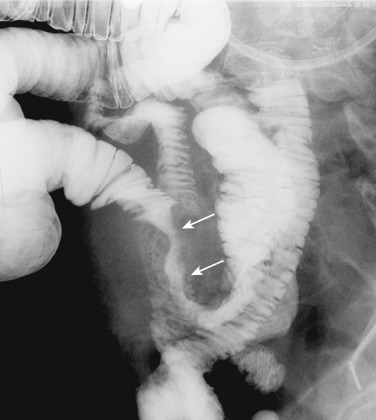
Peritoneal deposits may be seen as rounded protrusions toward the lumen of the small bowel. Discrete separation of ileal loops, often with a parallel configuration, angulated tethering of mucosal folds on their mesenteric border, and narrowing of loops are suggestive of peritoneal seeding associated with some desmoplastic reaction. Striking angulation and marked fixation of small bowel loops can be seen in primary cancers, causing a significant desmoplastic reaction, such as pancreatic or gastric carcinoma.
Multiple, round, polypoid nodules mostly seen along the antimesenteric border of the small bowel are the most common radiologic finding for hematogenous metastases, especially from a primary or malignant melanoma ( Figure 28-2 ). The metastatic nodules tend to ulcerate centrally, and, when the lesions are small, ulcerations appear as target lesions (“bull's eye” lesions) with collection of barium at the central ulcers. These nodules can act as a lead point for intussusception. Larger masses may have large ulcers or cavitations outlined with barium and may have a mass effect on the surrounding small bowel segments. Breast cancer metastases are rare but described as spreading through the submucosa, causing multiple strictures and intestinal obstruction. Metastases from lung or renal cell carcinoma are usually seen as solid or multiple large mesenteric masses with frequent ulcerations.
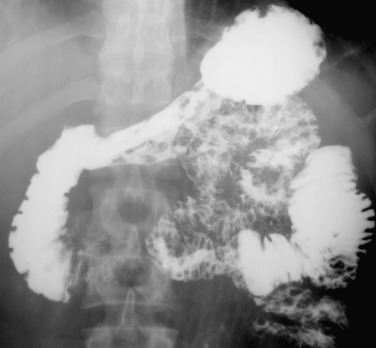
Computed tomography (CT) can show the metastatic lesions in the small bowel wall, mesentery, peritoneal surfaces, and lymph nodes and therefore can give a better idea about the size and extent of the disease. CT also can depict the extension of disease to the surrounding organs. Another advantage of CT is its ability to identify the primary tumor ( Figure 28-3 ). Intestinal bowel wall or peritoneal thickening (either nodular or plaque-like), mesenteric or omental nodules, and/or fat stranding are the common CT findings in patients with metastases to small bowel segments ( Figure 28-4 ). Metastases from melanoma manifest as enhancing mural nodules or focal thickening of the intestinal wall ( Figure 28-5 ).
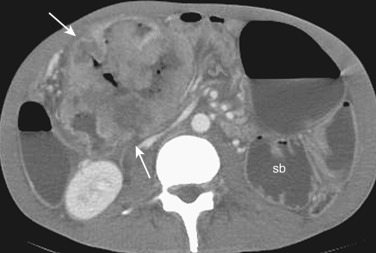
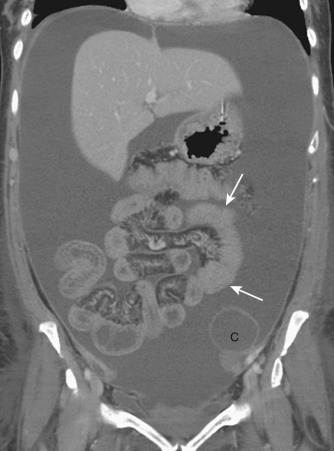
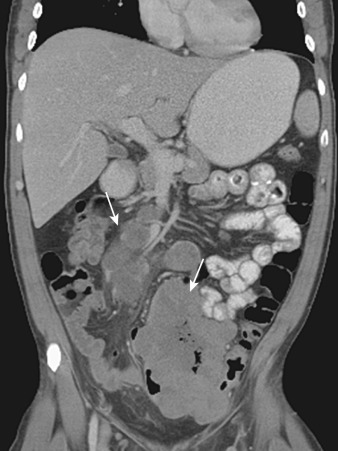
Magnetic resonance imaging (MRI) can provide a sensitive and accurate depiction of tumor involving the peritoneum and bowel serosa. Fat-suppressed, gadolinium-enhanced MRI is preferred for detection of small peritoneal or mesenteric tumors. Peritoneal tumors are found to be more conspicuous on delayed MR images obtained 5 to 10 minutes after intravenous injection of gadolinium. Even small implants can be depicted on delayed, fat-suppressed, gadolinium-enhanced gradient echo images. Diffusion weighted imaging in combination with conventional MRI is more accurate in detecting peritoneal metastasis.
Ultrasonography can be sensitive for detection of serosal, and superficial neoplastic deposits when performed with a high-frequency probe. However, it is limited in evaluating deposits between the loops or along the posterior wall. The focal thickened wall of the small bowel shows the nonspecific “pseudo-kidney” sign, which can be seen in both benign and malignant diseases.
Become a Clinical Tree membership for Full access and enjoy Unlimited articles
If you are a member. Log in here